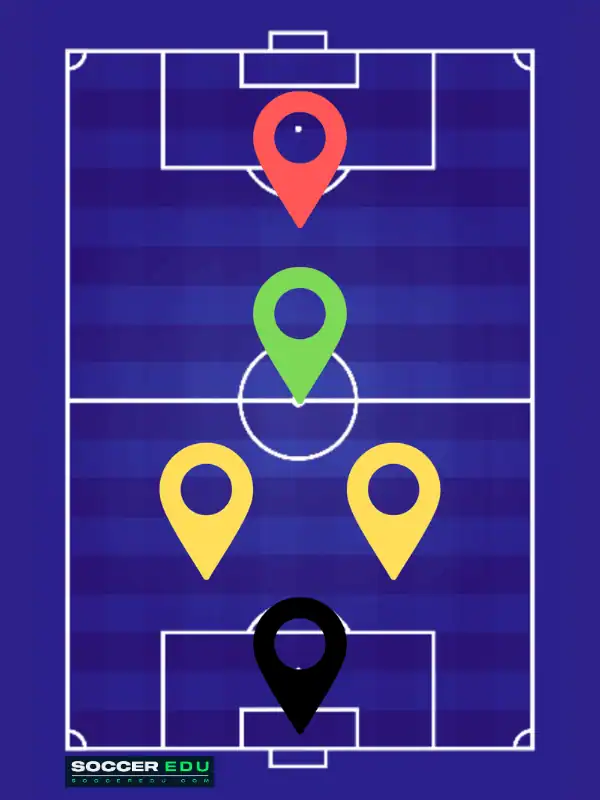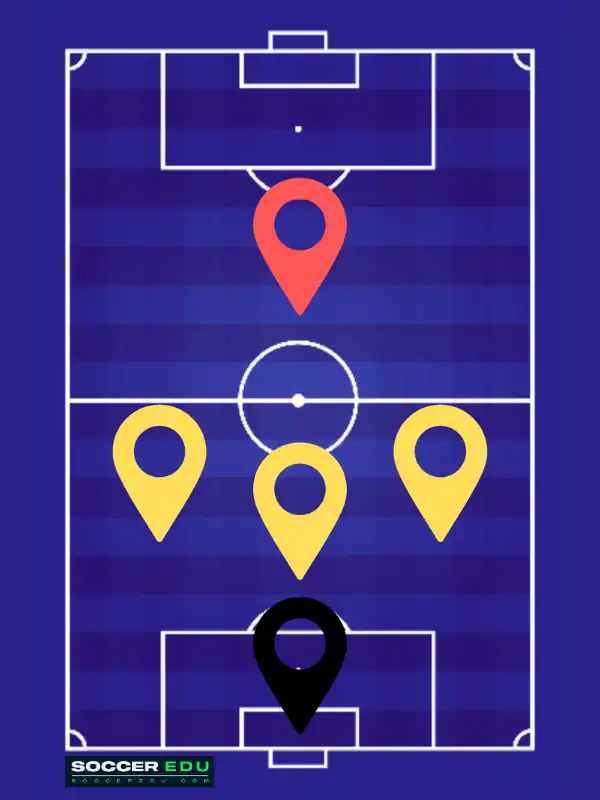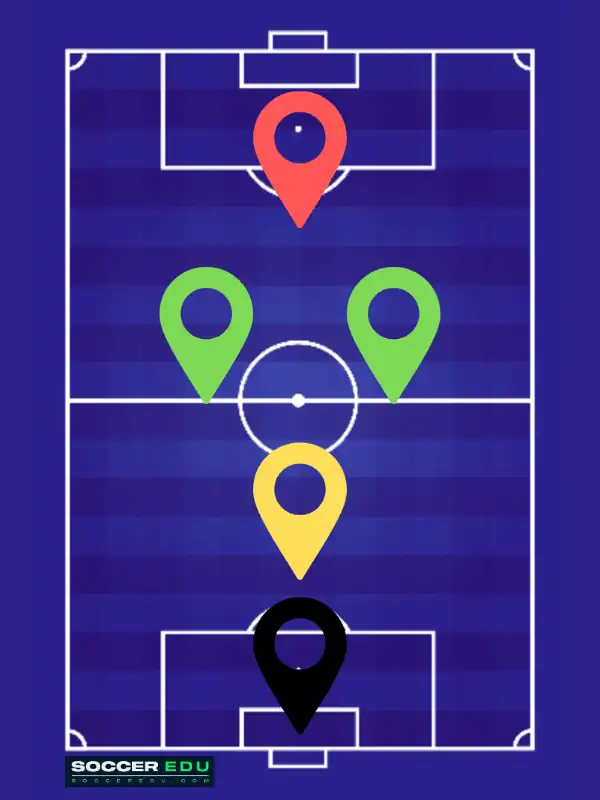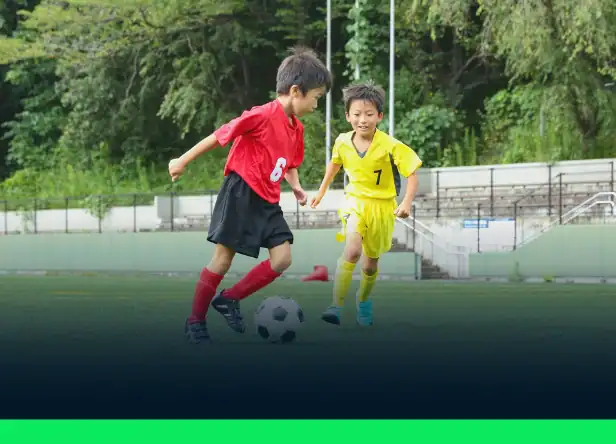5v5 soccer has experienced rapid growth in recent years. It offers a fresh approach to the game, with smaller teams and adapted playing fields. Let’s dive into what makes 5v5 soccer so exciting – from the basic rules to advanced tactical setups.
What Is 5v5 Soccer? Understanding 5v5 Soccer
Definition of Five-a-Side Soccer
5v5 soccer represents a condensed version of traditional soccer, featuring five players per side including one goalkeeper. This format places premium importance on technical ability, spatial awareness, and quick transitions between defensive and attacking phases. The reduced player count creates an environment where every touch matters and each player’s contribution becomes magnified.
According to recent industry analysis, small-sided soccer formats dominate participation rates in the United States, accounting for approximately 90% of all soccer involvement. This includes various formats such as 5v5 and futsal, reflecting the growing appetite for fast-paced, skill-focused soccer.
According to a 2025 report by FRANdata and For Soccer, small-sided soccer dominates participation in the U.S., accounting for about 90% of all soccer involvement. This includes formats like five-a-side soccer.
Five-a-Side or Futsal? Distinguishing 5v5 from Futsal
While both formats feature five players per side, several key distinctions separate 5v5 soccer from futsal:
Futsal characteristics:
- Played on hard surfaces (wood, linoleum, or rubber flooring) using flat-soled footwear
- Utilizes a heavier, low-bounce ball (typically size 4)
- Features unlimited rolling substitutions
- Played on larger dimensions (38-42m x 20-25m)
- Ball goes out of play when crossing boundary lines
5v5 soccer specifications:
- Contested on synthetic turf surfaces with specialized turf shoes
- Employs standard soccer balls (size 4 or 5) with regular bounce characteristics
- Often features perimeter barriers that keep the ball in play
- Smaller pitch dimensions (30-35m x 18-20m)
- Limited substitutions during match play
Both formats have gained tremendous momentum across Europe and internationally over the past decade, each offering unique tactical challenges and skill development opportunities.
Rules and Match Framework of 5v5 soccer
Field Specifications and Equipment
The 5v5 soccer playing environment is specifically designed to maximize player involvement and maintain high-intensity action:
Pitch dimensions: 30–35 metres in length by 18–20 metres in width
Goal specifications: 4 metres wide and 2 metres high
Squad composition: Maximum five players including one goalkeeper
Ball specifications: Size 4 futsal balls or size 5 traditional soccer balls may be utilized
Fundamental Match Regulations
Several rule modifications distinguish 5v5 from traditional 11v11 soccer:
- The ball is deemed out of play when contacting surrounding barriers, overhead netting, or exiting the field boundaries
- Deliberate goalkeeper handling outside the penalty area results in an indirect free kick
- Teams field a maximum of five players with up to three substitutes available
- Many venues eliminate the offside rule to encourage attacking freedom and creativity
Tactical Implications of Rule Changes
These rule modifications create distinct tactical considerations. The absence of offside encourages more direct attacking play and enables greater positional fluidity. The smaller pitch dimensions intensify pressing opportunities while simultaneously reducing time and space for decision-making.
Key Differences Between 5v5 and 11v11 Soccer
Characteristics of Small-Sided Play
Heightened intensity and individual responsibility: With only five players per team, every action becomes magnified in importance. Players experience significantly more ball contacts and must contribute across all phases of play.
Compressed spatial dynamics: The reduced field size places emphasis on close control, rapid passing combinations, and immediate decision-making under pressure. Players must demonstrate superior technical ability in tight spaces.
Enhanced individual engagement: Fewer teammates means each player assumes greater responsibility in both attacking and defensive phases, leading to more comprehensive skill development.
Technical skill prioritization: While tactical awareness remains important, 5v5 strongly promotes individual technical growth as players frequently face isolated decision-making scenarios.
Traditional 11v11 Characteristics
Positional specialization: The larger squad allows for clearly defined roles such as wing-backs, holding midfielders, and target forwards, enabling greater tactical specialization.
Expanded spatial considerations: Larger pitches favor longer passing ranges, extended attacking sequences, and higher cardiovascular demands. Ground-based passing combinations dominate over aerial play.
Collective tactical complexity: 11v11 relies heavily on coordinated unit movements, sophisticated pressing schemes, and intricate positional relationships between lines.
Role definition: With more players available, positions become more specialized, allowing teams to deploy dedicated defensive midfielders, attacking full-backs, and position-specific forwards.
Each format provides distinct developmental benefits: 5v5 encourages technical mastery and total involvement, while 11v11 develops advanced tactical understanding and positional discipline.
Optimal Formations in 5v5 Soccer
Even though 5v5 emphasizes individual brilliance, tactical organization remains fundamental to team success. The following formations represent the most effective structural approaches:
The 2-1-1 Formation (Fundamental Structure)

Composition:
- Two defenders (center-back partnership)
- One midfielder (box-to-box role)
- One forward (target player)
This represents the foundational system in 5v5 soccer, providing clearly defined roles that suit teams new to the format. The formation offers excellent balance between defensive stability and attacking potential, with the central midfielder serving as the crucial link between defensive and offensive phases.
Tactical advantages: Clear positional responsibilities, balanced field coverage, effective transitions
Ideal for: Beginning teams, players learning positional discipline, defensive stability
Weakness: Limited attacking width, potential midfield isolation under pressure
The 3-1 Formation (Defensive Solidity)

Structure:
- Three defenders (sweeper with two markers)
- One forward (lone striker)
This represents the premier defensive system in small-sided soccer. The compact three-player defensive unit restricts opposition space and frequently forces turnovers through coordinated pressing and covering movements.
Key strengths: Maximum defensive coverage, effective counter-attacking platform, numerical superiority in defensive third
Applications: Protecting leads, nullifying strong attacking teams, tournament knockout phases
Limitations: Reduced attacking options, reliance on individual forward brilliance
The 1-2-1 Formation (Diamond Configuration)

Setup:
- One defender (sweeper/libero)
- Two midfielders (wide support players)
- One forward (attacking focal point)
Recognized as the “diamond formation,” this system provides exceptional balance across all areas while enabling rapid transitions between phases. The two midfield players create triangular passing options and can support both defensive and attacking actions simultaneously.
Tactical benefits: Excellent field balance, rapid transition capability, strong central presence, flexible role interpretation
Suitable for: Experienced teams, possession-based play, technical players who can interchange positions
Vulnerabilities: Defensive exposure if players fail to track back, requires high fitness levels
The 1-3 Formation (Ultra-Attacking)

Formation:
- One defender (deep-lying playmaker)
- Three forwards (attacking trident)
This ultra-offensive system prioritizes high pressing, immediate ball recovery, and rapid goal conversion. Teams employing this formation seek to overwhelm opponents through numerical superiority in attacking areas.
Strategic advantages: Maximum attacking threat, intense pressing capability, quick score reversals
Usage scenarios: Chasing deficits, overwhelming weaker opposition, final periods requiring goals
Risk factors: Significant defensive vulnerability, requires exceptional fitness, susceptible to counter-attacks
Advanced Tactical Considerations
Pressing and Defensive Strategies
Effective pressing in 5v5 requires coordinated unit movement and intelligent trigger recognition. Teams must identify optimal moments to apply pressure:
Pressing triggers: Poor first touches, sideways passes under pressure, goalkeeper distributions, set-piece situations
Coordinated pressing: All outfield players must press simultaneously to prevent easy bypass passes
Recovery positioning: When pressing fails, immediate defensive recovery becomes crucial to prevent counter-attacks
Positional Flexibility and Role Rotation
Modern 5v5 soccer emphasizes positional interchange and role fluidity. Players must demonstrate competency across multiple positions:
Defensive rotation: Center-backs advancing into midfield roles while midfielders drop to cover
Attacking overloads: Full commitment to attacking phases with coordinated defensive recovery
Transition speed: Rapid switching between attacking and defensive mindsets
Formation Adaptation During Matches
Successful 5v5 teams demonstrate tactical flexibility by adapting formations based on match circumstances:
- Leading situations: Shift to more conservative structures (3-1 or defensive 2-1-1)
- Deficit scenarios: Adopt aggressive pressing formations (1-3 or attacking 1-2-1)
- Opposition analysis: Counter opponent strengths through tactical adjustments
Tactical Parallels with 11v11 Systems
Understanding formation relationships between 5v5 and traditional soccer provides valuable tactical insight:
- 2-1-1 mirrors 4-3-3: Balanced structure with fluid transitions
- 3-1 resembles 5-3-2: Solid defensive foundation with counter-attacking threat
- 1-2-1 parallels 4-4-2: Comprehensive field coverage across all zones
- 1-3 reflects 3-4-3: Ultra-attacking mentality with high pressing intensity
Implementation and Training Considerations
Physical Preparation
5v5 soccer demands specific fitness attributes:
Cardiovascular requirements: Short-burst anaerobic capacity, rapid recovery between high-intensity efforts
Agility development: Quick direction changes, close control under pressure, reactive movements
Strength considerations: Core stability for shielding, leg strength for explosive movements
Technical Skill Priorities
Ball mastery: Enhanced first touch, close control in confined spaces, rapid directional changes
Passing accuracy: Short, precise passes under pressure, one-touch combinations, quick release
Shooting technique: Finishing from various angles, shots under pressure, goalkeeping distribution
Tactical Training Methods
Small-sided games: 3v3 and 4v4 exercises to simulate match conditions
Pressing drills: Coordinated unit pressing, trigger recognition, recovery runs
Transition training: Rapid switching between attacking and defensive phases
Conclusion: The Ultimate 5v5 Takeaway
5v5 soccer formations such as the 2-1-1, 3-1, 1-2-1, and 1-3 provide coaches with versatile tactical frameworks for developing comprehensive game plans. Each system offers distinct advantages depending on team characteristics, opposition analysis, and match circumstances.
The format transcends simple scaling down of traditional soccer, it represents a dynamic, skill-driven variant that challenges players to think faster, move more intelligently, and perform at peak levels in every action. Through understanding these tactical foundations and their practical applications, coaches can build tailored strategies while players develop both collective understanding and individual technical excellence.
Success in 5v5 soccer ultimately depends on tactical adaptability, technical proficiency, and the ability to execute coordinated team movements within the unique constraints and opportunities that small-sided soccer provides. Whether employed for youth development, recreational competition, or professional small-sided leagues, these formations offer the strategic foundation necessary for elevated performance and tactical sophistication.





